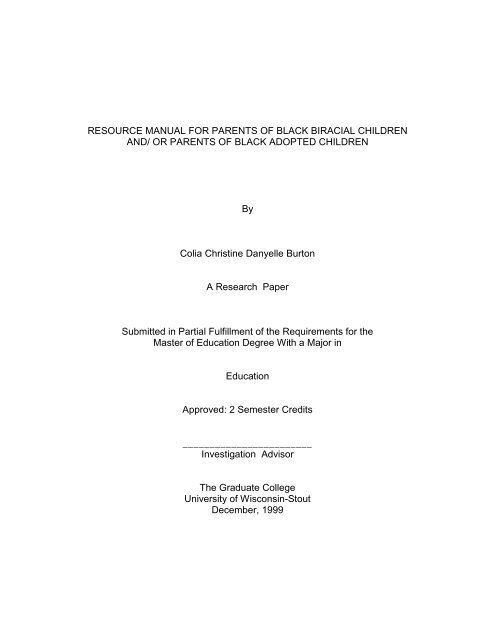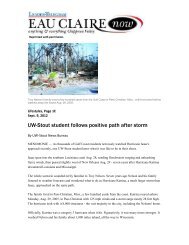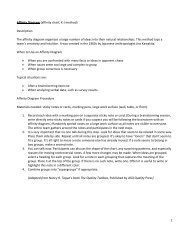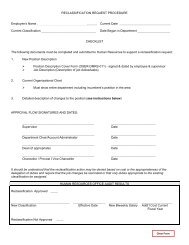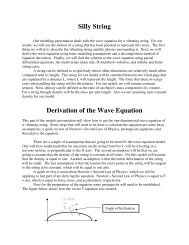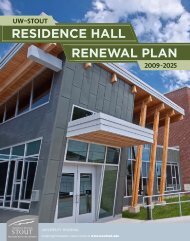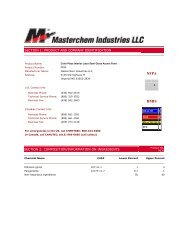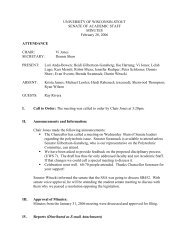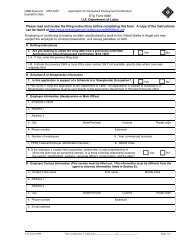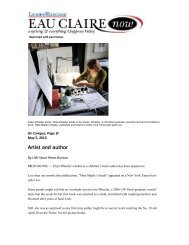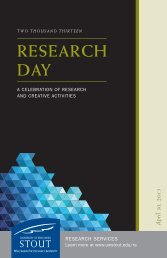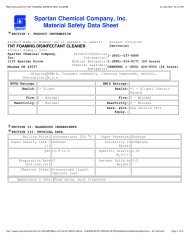resource manual for parents of black biracial children - MINDS@UW ...
resource manual for parents of black biracial children - MINDS@UW ...
resource manual for parents of black biracial children - MINDS@UW ...
- No tags were found...
You also want an ePaper? Increase the reach of your titles
YUMPU automatically turns print PDFs into web optimized ePapers that Google loves.
RESOURCE MANUAL FOR PARENTS OF BLACK BIRACIAL CHILDRENAND/ OR PARENTS OF BLACK ADOPTED CHILDRENByColia Christine Danyelle BurtonA Research PaperSubmitted in Partial Fulfillment <strong>of</strong> the Requirements <strong>for</strong> theMaster <strong>of</strong> Education Degree With a Major inEducationApproved: 2 Semester Credits________________________Investigation AdvisorThe Graduate CollegeUniversity <strong>of</strong> Wisconsin-StoutDecember, 1999
iiACKNOWLEDGEMENTThere was a great number <strong>of</strong> people that played a major role in helpingme complete my paper. To these people I give a very sincere thank you to .First and <strong>for</strong>emost I would like to thank God <strong>for</strong> allowing me to reach mygoals and seeing them through because with out his guidance I would not bewhere I am today.Thank you to my loving and dedicated family <strong>for</strong> sticking beside me andbelieving in me when so many were willing to give up on me.To my <strong>children</strong>, Lynteria, TaSawn and Shakayla, who I love more than lifeitself. Thank you <strong>for</strong> allowing me to use you as my “guinea pigs”.To Jane, who countless times watched my <strong>children</strong> so that I could get my paperdone and she always pushed me to get it done.Finally, I would like to dedicate this paper to the memory <strong>of</strong> mygrandmother Julia Mae Burton. Thank you <strong>for</strong> always being there <strong>for</strong> me and <strong>for</strong>raising me to be a strong and dedicated Black woman afraid <strong>of</strong> nothing especiallyfailure. Even though she was unable to see me complete my paper, she wasthere in spirit when she held my hand and walked me across the stage toreceive my diploma.
iiiThe Graduate CollegeUniversity <strong>of</strong> Wisconsin-StoutMenomonie, Wisconsin 54751ABSTRACTBurton Colia C.D.(Writer) (Last name) (First) (Initial)Resource Manuel For Parents <strong>of</strong> Black Biracial Children and/or Parents <strong>of</strong> BlackAdopted Children(Title)Education Amy Gillett December, 1999 26(Graduate Major) (Research Advisor) (Month/Year) (No. <strong>of</strong> Pages)APA___________________________________________________________(Name <strong>of</strong> Style Manual Used in this Study)The United States is vastly becoming a multicultural society. Interactionamong various ethnic groups is essential <strong>for</strong> everyday business transactions.There are more than 700,000 interracial married couples in the United States andan estimated almost five million interracial or <strong>biracial</strong> <strong>children</strong>. As a result, these<strong>children</strong> and <strong>parents</strong> are reaching out to embrace various means to fullyunderstand themselves and where they belong. These <strong>children</strong> and <strong>parents</strong> aresometimes being <strong>for</strong>ced to choose a “side” to relate to in order to fit in. theseindividuals are learning that they do not have to “belong” to just one group, theycan be a part <strong>of</strong> both <strong>of</strong> their <strong>parents</strong> culture without consequences. Also there isa large increase in the number <strong>of</strong> Black <strong>children</strong> being adopted by non Blackiv<strong>parents</strong>. It is a continues learning process <strong>for</strong> both the <strong>parents</strong> as well as the<strong>children</strong> that they have or have adopted to get in<strong>for</strong>mation about who they are,see books that depict <strong>children</strong> and adults like them, and to have support groupsto help with the everyday challenges that they have. These individuals arelooking <strong>for</strong> various organizations, web sites, literature, and others like themselvesthat they can relate with.This paper will conclude with an actual research <strong>manual</strong> that <strong>parents</strong>,<strong>children</strong>, and educators can use to further their knowledge <strong>of</strong> a growing culture.
VTABLE OF CONTENTSAcknowledgements………………………………………………………….iiAbstract………………………………………………………………………..iiiTable <strong>of</strong> Contents…………………………………………………………….vCHAPTER ONE- IntroductionIntroduction……………………………………………………………1Statement <strong>of</strong> the Problem……………………………………………1Objectives……………………………………………………………..2Definitions <strong>of</strong> Terms………………………………………………….3Assumptions…………………………………………………………..4Limitations……………………………………………………………..4CHAPTER TWO- Review <strong>of</strong> LiteratureIntroduction……………………………………………………………5Adoption <strong>of</strong> Black and/or Black Biracial Children………………...7Self-Identity……………………………………………………………9Family Expectations………………………………………………….13CHAPTER THREE- MethodologyIntroduction……………………………………………………………15Citation Locations…………………………………………………….15CHAPTER FOUR- Resource ManualIntroduction……………………………………………………………17vi
Resource Manual………………………………………………….18References…..……………………………………………………………..25
1CHAPTER ONEIntroductionThere have been various material (Rinaldo, 1967; Nash, 1993; Korgen, 1998;Grow & Shapiro, 1974; Wardle, 1999) that have reported a need to address the needs<strong>of</strong> <strong>biracial</strong> <strong>children</strong> in the <strong>for</strong>m <strong>of</strong> a <strong>resource</strong> <strong>manual</strong> <strong>for</strong> their <strong>parents</strong>. From the materialthat has been read, there are no condensed <strong>manual</strong>s or <strong>resource</strong> devices that aid these<strong>parents</strong> with the needed help to deal with common every day issues and concerns suchas self-esteem, self identity, racism, grooming needs, literature selections, and ethnicpride.The history <strong>of</strong> Black Biracial Americans began soon after the arrival <strong>of</strong> the firstAfricans in North America (Korgen, 1998). In 1662, the Virgina Assembly declared thatBlack Biracial <strong>children</strong> born to female slaves were also slaves. Currently there are anestimated 700,000 interracial married couples and an estimated 5 million Black Biracial<strong>children</strong> (Procter & Gamble, 1999). Due to the growing increase <strong>of</strong> <strong>children</strong> born <strong>of</strong>Black racially mixed decent, literature, support groups, and <strong>resource</strong>s need to beavailable.Statement <strong>of</strong> the ProblemThe purpose <strong>of</strong> this study is to develop a <strong>resource</strong> <strong>manual</strong> that will aid <strong>parents</strong>,guardians, and/or care givers with the knowledge base to have and raise a mentally,physically, emotionally, and spiritually healthy child that might be <strong>biracial</strong>, racially mixed,biethnic, or adopted. This study will focus on2gathering in<strong>for</strong>mation <strong>for</strong> these <strong>parents</strong> to ensure that the child that they are raising orcaring <strong>for</strong> grows up with the essential skills he or she needs to become healthy,confident, and ethnically rich in his or her culture. In addition to becoming emersed inhis or her own culture, they will learn about the new culture he or she has beenintroduced.The <strong>resource</strong> <strong>manual</strong> will be made available in the spring <strong>of</strong> 2000. Oncecompleted, the <strong>resource</strong> <strong>manual</strong> will be randomly sent to schools, day care centers,church organizations, human services departments, and other local businesses andorganizations that might have clientele that might benefit from its use. This <strong>resource</strong><strong>manual</strong> will be free and they will be reproducible <strong>for</strong> the organization to use as <strong>of</strong>ten asthey need.Resource ObjectivesThere will be three main objectives that this study will address. They are:1. To develop a list <strong>of</strong> grooming <strong>resource</strong>s, specifically dealing withthe child’s hair, that the <strong>parents</strong> might use <strong>for</strong> their <strong>biracial</strong>, racially mixed, and/orbiethnic <strong>children</strong>.
2. To develop a list <strong>of</strong> literature <strong>resource</strong>s that depict <strong>biracial</strong>, racially mixed, and/orbiethnic <strong>children</strong> in positive ways. This list will also include literature <strong>for</strong> the <strong>parents</strong> <strong>of</strong>these <strong>children</strong>.3. Develop a <strong>resource</strong> list <strong>of</strong> various networking options that might3include support groups, local organizations that specialize in helping <strong>parents</strong> <strong>of</strong> <strong>biracial</strong>,racially mixed, and/or biethnic <strong>children</strong>, and web sites <strong>for</strong> future exploration.Definition <strong>of</strong> TermsTo fully understand the terms indicated in this study, clarification on the definition<strong>of</strong> some words are needed:Biethnic - belonging to two ethnic groups.Biracial - having <strong>parents</strong> <strong>of</strong> two dissimilar racial groups one <strong>of</strong> which is Black.Cross racial/Transracial adoption - adoption <strong>of</strong> a child who is <strong>of</strong> a different racialheritage than the individual or individuals that have adopted the child.Hair care products - refers to products that are especially designed <strong>for</strong> individualswho have hair <strong>of</strong> a coarse or semi coarse nature. These items help to give life andmoisture to the individuals hair.Healthy - refers to the ability to care <strong>for</strong> yourself through proper groomingtechniques and other options. It also looks at self esteem, self identity, and self worth.Identity - the distinguishing unique personality <strong>of</strong> an individual.Networking Options - refers to groups <strong>for</strong>med nationwide, web pages, andorganizations in the community designed to help <strong>parents</strong> <strong>of</strong> <strong>biracial</strong>,4racially mixed and/or biethnic <strong>children</strong> deal with every day questions, and concerns.Parent - refers to the guardian, immediate caregiver, or adult who is over seeingthe well being <strong>of</strong> the <strong>biracial</strong>, racially mixed, and/or biethnic child.AssumptionsThere are two assumptions which became apparent through the research. Theyare:1. The <strong>parents</strong> <strong>of</strong> racially mixed <strong>children</strong> need additional material to aidthem with their <strong>children</strong>.2. The <strong>parents</strong> <strong>of</strong> these <strong>children</strong> will utilize and share the newly gainedin<strong>for</strong>mation with friends, relatives, and co-workers that might be in asimilar situation.LimitationsThere was one limitation to the study that was conducted. The limitation was thefact that the <strong>manual</strong> and <strong>resource</strong> material was solely aimed at <strong>parents</strong> who have Black<strong>biracial</strong> <strong>children</strong> or have adopted Black or Black <strong>biracial</strong> <strong>children</strong>. There<strong>for</strong>e this<strong>resource</strong> <strong>manual</strong> will not be as valuable a tool <strong>for</strong> <strong>parents</strong> <strong>of</strong> <strong>children</strong> that do not fit thetargeted population.
5CHAPTER TWOReview <strong>of</strong> LiteratureIn this chapter, the reader will find in<strong>for</strong>mation concerning the history <strong>of</strong> howBirracial <strong>children</strong> came to be in existence. Also, in this chapter the reader willreceive in<strong>for</strong>mation about adoption, self-identity, and family exceptance <strong>of</strong> theBirracial child.The United States is a multicultural society, a society in which acceptance<strong>of</strong> differences are changing <strong>for</strong> the better every day (Watts, 1989). Interracialdating and interracial marriages have been a hot topic since the first African wasbrought to the United States (Korgen, 1998). A Dutch man-<strong>of</strong>-war gave theEnglish colonists <strong>of</strong> Virginia 20 Africans in exchange <strong>for</strong> food supplies. Shortlythere after, the first <strong>biracial</strong> individual was born in the United States (Korgen,1998). As a result <strong>of</strong> these unions between Whites and Africans, <strong>children</strong> wereborn that depicted both races. Politicians and other men <strong>of</strong> power had to decidewhat was to be done with these <strong>children</strong> that were born <strong>of</strong> one White parent andone African parent when one was a slave. The politicians referred to these<strong>children</strong> as mulatto. According to Korgen, what these politicians and men <strong>of</strong>power found was Whites (that were slaves <strong>for</strong> a short period <strong>of</strong> time) and Africanslaves becoming friends as they worked side by side in the fields and in somecases these White and African slaves slept side by side. Some <strong>of</strong> these slaveseven took their friendship a step further by becoming lovers (Korgen, 1998). Thevarious political leaders tried to separate the White slaves from the ‘heathen’6Africans, but their attempts came too late. The slaves were mating and having<strong>biracial</strong> <strong>children</strong> (Rinaldo, 1967). The question was whether or not the child <strong>of</strong> aWhite slave and an African slave was also a slave. In 1662 the VirginiaAssembly met and declared that “mulatto <strong>children</strong> born <strong>of</strong> one White slave parentand one Negro slave parent would also be a slave”(Korgen, 1998, p.11). Later onthe “one drop rule” came into place. This rule was created to prevent progeny <strong>of</strong>interracial relationships becoming free men and women. The rule implied that ifany person in America with any <strong>black</strong> heritage what-so-ever must be declaredBlack (Wardle, 1999).Be<strong>for</strong>e the end <strong>of</strong> slavery, punishment to White women that bore <strong>biracial</strong><strong>children</strong> was extremely severe (Korgen, 1998). According to Korgen, in 1705, if acouple decided to wed and bare <strong>children</strong> <strong>of</strong> a <strong>biracial</strong> nature, they were bannedfrom the colony or even worse, killed to be a lesson to others that wereconsidering marrying Africans. Today such drastic measures do not exist. There
have been numerous movements to establish equality between races to giveindividuals freedom to choose who they will marry. As a result <strong>of</strong> this freedom,various interracial marriages have been established. From these marriages (andother <strong>for</strong>ms <strong>of</strong> unity) <strong>biracial</strong> <strong>children</strong> have come into existence.According to Powell and Rosenblatt (1995), <strong>parents</strong> tended to be veryconfident and literate in their own culture, but lacked the ability to understand theculture <strong>of</strong> their new creation, their child. Currently there are an estimated 700,000interracial married couples and an estimated 5 million Black <strong>biracial</strong> <strong>children</strong>7(Procter & Gamble. 1999). Because <strong>of</strong> this growing phenomenon, the need tohave access to literature about Black <strong>biracial</strong> <strong>children</strong>, support groups, and websites is in high demand to aid the <strong>parents</strong> <strong>of</strong> these <strong>biracial</strong> <strong>children</strong>.When conducting the research <strong>for</strong> this study, the researcher came acrossseveral topics that needed further exploration to fully understand and obtainideas <strong>of</strong> what these <strong>parents</strong> needed.AdoptionAdoption is an option that some <strong>parents</strong> choose to take to minimize thefact that there are more <strong>children</strong> in this world than potential homes (Grow &Shapiro, 1974). The need <strong>for</strong> permanent homes <strong>for</strong> Black <strong>children</strong> has been amajor concern <strong>of</strong> the Office <strong>of</strong> Child Development and <strong>of</strong> the Welfare League.According to Grow and Shapiro (1974), the Child Welfare League has alwaysstressed the desirability <strong>of</strong> placing <strong>children</strong> with families <strong>of</strong> the same race orethnic background. It has also taken the position that a child should not be
deprived <strong>of</strong> a family because <strong>of</strong> the unavailability <strong>of</strong> a family <strong>of</strong> the same race(Grow and Shapiro, 1974). In many instances, agency policies were modified toattract more Black adoptive applicants, but since the agency did not attractenough Black applicants <strong>for</strong> the Black <strong>children</strong> in need <strong>of</strong> permanent homes,some agencies began to experiment with transracial adoption. There werenumerous critiques <strong>of</strong> transracial adoption. The vast majority <strong>of</strong> the critiques feltthat a Black child that was adopted by a White family would lose his/her identity8with his/her racial and cultural heritage and would become confused by the newculture and heritage that he/she was introduced.Be<strong>for</strong>e deciding to adopt a child <strong>of</strong> another race, or even one that hasdarker hair color, <strong>parents</strong> have to typically go through a kind <strong>of</strong> self-examination(Register, 1991). The <strong>parents</strong> must consider the meaning <strong>of</strong> the differences thatexist and think through how it might affect the parental relationship with the childthe parent chooses to adopt. According to Register (1991), the <strong>parents</strong> need toalso ask themselves the following questions:-How will I feel having a child that does not look like me?-Am I capable <strong>of</strong> handling any problems this relationship might create?-Will I be accepting <strong>of</strong> criticism from my peers, family, and community?-If given the chance, would I be willing to marry interracially?Once a parent has given serious thought to these questions and otherquestions like these, the parent can begin the first step toward adopting a child
from a different race, especially one that will not have the same hair or skin color(Register, 1991).The next step that <strong>parents</strong> that want to participate in transracial adoptionneed to do is go through a series <strong>of</strong> counseling sessions to prepare them <strong>for</strong> theadoption. Generally no one takes a 4 year course in parenting be<strong>for</strong>e they areallowed to have <strong>children</strong> and become <strong>parents</strong>. Every day is a learning experience<strong>for</strong> new <strong>parents</strong>. The same thing holds true <strong>for</strong> <strong>parents</strong> that adopt a Black<strong>biracial</strong> or Black child. No matter how many books and <strong>resource</strong>s are available to9an individual, the individual will never be fully prepared <strong>for</strong> the day to dayincidents that come up with the new child (Nash, 1993).Many <strong>children</strong>, when they are small, tend to experience problems withplaymates who want to know why the ‘brown’ doesn’t come <strong>of</strong>f when they washtheir hands or when they get a little older, which race do they belong to. The<strong>children</strong> will even go so far as to tease them if they are unable to identify with therace <strong>of</strong> the taunter (Rinaldo, 1967). According to Rinaldo, even <strong>parents</strong> whobelieve they have no prejudices are <strong>for</strong>ced to confront their own suppressedfeelings when a child that they are caring <strong>for</strong> is faced with racism and prejudice.As long as <strong>parents</strong> are modeling the proper behavior and ways <strong>of</strong> dealing withsituations <strong>of</strong> this nature, the child will learn from it and benefit in the long run(Rinaldo, 1967).Self-Identity
The second topic that seemed to be a big concern <strong>of</strong> all <strong>of</strong> the <strong>resource</strong>sthat were collected was self-identity. In most cases a child that is <strong>of</strong> a biethnicunion tends to have some confusion when it comes to deciding which ethnicgroup he/she belongs to (Nash, 1993). According to Nash, generally these<strong>children</strong> do not know which racial group to associate with and feel that they mustchoose a race and in some cases Black <strong>biracial</strong> <strong>children</strong> feel that they arechoosing one parent over the other by doing so. Only when a Black <strong>biracial</strong> childhas developed a sense <strong>of</strong> their racial identity, can he/she grow to be a healthyadult, getting over the fear <strong>of</strong> having to choose one parent over the other.10According to Nash, racial identity refers to a person’s pride in his/her racial andcultural background. In order to show pride in those areas, individuals need tobecome familiar with their racial and cultural background. Parents <strong>of</strong> Black<strong>biracial</strong> <strong>children</strong> can aid them by surrounding Black <strong>biracial</strong> <strong>children</strong> with books,videos, pictures, and recordings that speak about the <strong>children</strong>’s racial andcultural background in a positive non-stereotypical way (Korgen, 1998). Korgenfelt that once an individual took hold <strong>of</strong> their racial identity they can possess thefollowing skills: they will be able to <strong>for</strong>m the way they deal with others and theway others react to them; help shape their attitude about themselves; begin tolike themselves <strong>for</strong> who they are and nothing less; and realize that they belong inboth cultures and can get the best <strong>of</strong> both.Some individuals reach this stage at an early age when there is a greatdeal <strong>of</strong> parental involvement and community support (Nash, 1993). Once an
individual has reached this stage, they can help people that are notknowledgeable in other cultures and diverse groups. For Black <strong>biracial</strong>individuals to be proud <strong>of</strong> their culture and race does not mean that they arebetter than others (Nash, 1993). It simply means that they will be able to move onwhen others are being ignorant and using inappropriate terms to describe themor others like them.Korgen (1998) found that if a Black <strong>biracial</strong> child was not exposed to otherBlacks or received in<strong>for</strong>mation relating to his/her culture, he/she tended to beafraid <strong>of</strong> other Black people and was not accepting <strong>of</strong> Black culture. Many Black11<strong>biracial</strong> <strong>children</strong> raised in upper middle class, predominantly whiteneighborhoods, find they have little in common with African Americans they meetwho live in different areas (Korgen, 1998). Korgen also found that some Black<strong>biracial</strong> individuals are so eager to please that they will date a Black person justto fulfill the Black ‘half’ <strong>of</strong> them, instead <strong>of</strong> doing what makes them happy. Withthe right exposure and the proper modeling, Black <strong>biracial</strong> <strong>children</strong> will not feel“pressured” to date someone just because they are the “right” race.“…visible minority <strong>children</strong> encounter discom<strong>for</strong>ting experiences in theschool system and on the playgrounds” (Ambert, 1992, p. 220). Teachers mightembrace a visibly minority child to per<strong>for</strong>m at a lower level in quality and quantity.The child might accept the teacher’s evaluation <strong>of</strong> him/her as less capable andthere<strong>for</strong>e fulfill those expectations <strong>of</strong> inferiority (Ambert,1992). According toAmbert, <strong>parents</strong> can make the transition into school as smooth as possible by
talking with the teacher ahead <strong>of</strong> time and explaining your family’s expectations.Parents can also minimize some <strong>of</strong> the stress and tension <strong>of</strong> a new school by:1. Going to parent school board meetings and voting on new policies thatmight eventually relate to their child.2. Participating in various holiday celebrations that might pertain to theirChild.3. Networking with other <strong>parents</strong> <strong>of</strong> Black <strong>biracial</strong> <strong>children</strong> in their child’sschool and sharing the work load <strong>of</strong> getting new <strong>resource</strong>s and literature<strong>for</strong> their child’s school.124. Addressing concerns that occur with their child with the teacher in a calmfashion.5. Be open to criticism that may come up concerning their child.According to Pan (1997), a child’s school counselor can also bea very <strong>resource</strong>ful person to help boast the child’s self-esteem, selfidentity, and self concept. Because Black <strong>biracial</strong> <strong>children</strong> are particularlyvulnerable to differential treatments by their <strong>parents</strong>, relatives, and peers, acounselor can aid <strong>parents</strong> with techniques to minimize this fromhappening. Pan gave the following suggestions <strong>for</strong> counselors to give to<strong>parents</strong> <strong>of</strong> Black <strong>biracial</strong> <strong>children</strong> (Pan, 1997).-Conduct a careful self examination <strong>of</strong> their personal attitudes towardinterracial marriages and <strong>biracial</strong> <strong>children</strong>.-Provide a broad description (verbal and visual) <strong>of</strong> possible family
compositions when the families are the topic.-Expand the concept <strong>of</strong> one’s cultural background to include multiplecultural heritages.-Emphasize that diversity goes beyond the acknowledgement <strong>of</strong> racialgroups to include <strong>biracial</strong> people, different lifestyles, age, gender orientation, andphysical disabilities.-Be sensitive to the dilemmas <strong>of</strong> Black <strong>biracial</strong> <strong>children</strong> when topicspertaining to personal and group identity are presented.13Day (1979), conducted a study <strong>of</strong> 125 whites who had adopted <strong>black</strong><strong>children</strong> and found that more than half <strong>of</strong> the <strong>parents</strong> reported that all <strong>of</strong> theirrelatives supported them right from the beginning. Many <strong>parents</strong> talked about itbeing absolutely essential that a Black <strong>biracial</strong> child have a clear, positive, andresilient sense <strong>of</strong> identity, which is achieved through positive support from otherfamily members (Powell & Rosenblatt, 1995).Family ExpectationsIf a family does not have a strong family support system, the idea <strong>of</strong>having a Black <strong>biracial</strong> child or adopting a Black child is too overwhelming(Rinaldo, 1967). Nonverbal communication such as facial expressions and handgestures are clear indicators as to how an individual truly feels about a person.The family members might feel threatened that the entire family will be viewed asa minority (Register, 1991). In some cases, while accepting their grand<strong>children</strong> or
niece/nephew, some relatives nonetheless held onto their stereotypes andviewed their Black <strong>biracial</strong> family members as different from other Blacks (Day,1979).According to Wardle (1999), families with Black <strong>biracial</strong> <strong>children</strong> who havelearned how to cope in a racist society <strong>of</strong>ten have a higher self-esteem and astronger sense <strong>of</strong> personal identity than families who have not learned how tocope. Families should use their differences as learning tools. Only when culturaldifferences are respected, will <strong>children</strong> learn to accept and be proud <strong>of</strong> bothcultures. In addition to the advantages that come with knowing two worlds and14having dual perspectives, a Black <strong>biracial</strong> child’s family can gain educationalbenefits available to families with Black <strong>biracial</strong> <strong>children</strong>. These benefits havebeen established to achieve educational goals <strong>for</strong> the whole population and toattempt to reduce the damage caused by racism (Powell & Rosenblatt, 1995).In conclusion, there are numerous topics that Black <strong>biracial</strong> <strong>children</strong> andBlack <strong>children</strong> face in every day life. Through the use <strong>of</strong> a <strong>resource</strong> <strong>manual</strong>, a lot<strong>of</strong> this stress will be minimized by providing <strong>parents</strong> with the correct <strong>resource</strong>s toseek help and gain in<strong>for</strong>mation on certain topics. All <strong>of</strong> the individuals involvedwith the child’s life need to take an active role in aiding with the upbringing <strong>of</strong> thechild. The further exploratory growth that the <strong>parents</strong> and caregivers do, thehealthier the child will be.15
CHAPTER THREEMethodologyIn this chapter the reader will find out how the <strong>resource</strong>s were gatheredand collected <strong>for</strong> the actual <strong>resource</strong> <strong>manual</strong>. Also, in this chapter the reader willfind out how the actual guide is structured to aid the <strong>parents</strong> and guardians to getthe most out the <strong>resource</strong> guide.The majority <strong>of</strong> the literature in<strong>for</strong>mation <strong>for</strong> the <strong>resource</strong> guide wascollected from two main sources: the library located at the University <strong>of</strong>Wisconsin- Stout in the <strong>children</strong>’s section also know as the E.M.C. (EducationalMaterials Collection) and the internet looking at various sights set up to help<strong>parents</strong> <strong>of</strong> Black and Black <strong>biracial</strong> <strong>children</strong> and Black adopted <strong>children</strong> .The first place that was utilized was the <strong>children</strong>’s section at the library atthe University <strong>of</strong> Wisconsin-Stout. The Educational Materials Collection (E.M.C),has an abundant amount <strong>of</strong> <strong>children</strong>’s books, audio visual equipment, s<strong>of</strong>tware,and teacher <strong>resource</strong>s to use. These items are separated by call numbers andcan be easily accessed through the campus computer by title, author, and/orsubject.The next place investigated <strong>for</strong> the <strong>resource</strong> <strong>manual</strong> was the internet.There were various sites and locations dedicated to <strong>biracial</strong> issues. These siteswere divided by categories <strong>of</strong> families and their interests.16
The actual <strong>resource</strong> guide was designed with the readers in mind. Eachsection is divided into four easy to follow categories: Children’s books, on linesites, support groups and other help agencies, and adult literature. After each<strong>resource</strong>, the subject is stated. The <strong>children</strong>’s books have a variety <strong>of</strong> topicsand/or have <strong>children</strong> that are Black and/or Black <strong>biracial</strong> as their main character.The on line sites are sites that anyone can use to obtain more in<strong>for</strong>mation oncurrent Biracial topics and ideas. There are also places <strong>for</strong> individuals to chatwith other individuals that might share common interests. The support groupsand agencies are ones that are set up to be a ‘crutch’ <strong>for</strong> both <strong>parents</strong> <strong>of</strong> Blackand Black <strong>biracial</strong> <strong>children</strong> and their <strong>children</strong> as well. The adult literature that iscited is a composed list <strong>of</strong> literature that might give additional insight <strong>for</strong> <strong>parents</strong>on how to deal with certain situations as they arise within their family. There arealso books that aid <strong>parents</strong> dealing with the fact that everyone might not beaccepting <strong>of</strong> their families and how to get beyond that point.The <strong>resource</strong> guide is just the start <strong>of</strong> a collection <strong>of</strong> valuable literature, online sites, support groups, and adult literature. The researcher’s plan is <strong>for</strong> the<strong>resource</strong> <strong>manual</strong> to grow as the readers utilize it by adding new <strong>resource</strong>s thatthey encounter.CHAPTER FOURResource Manual17In the chapter the reader will find the actual <strong>resource</strong> <strong>manual</strong>. This<strong>manual</strong> will be composed <strong>of</strong> four sections; <strong>children</strong>’s books, on line sites,
support groups and agencies, and adult literature. Prior to each section abrief description <strong>of</strong> what the reader will find will be indicated. The <strong>resource</strong><strong>manual</strong> is by no means complete. It is designed to give <strong>parents</strong> andguardians a place to start as far as getting in<strong>for</strong>mation, books, and help <strong>for</strong>themselvesand their family.18Resource Manual <strong>of</strong> Parents <strong>of</strong> Black Biracial Children and/orParents <strong>of</strong> Black adopted Children
The following collection <strong>of</strong> books, support groups, and on line sites, is acollection <strong>of</strong> <strong>resource</strong>s gathered to aid <strong>parents</strong> and guardians <strong>of</strong> Black <strong>biracial</strong><strong>children</strong> and/or <strong>parents</strong> <strong>of</strong> Black adopted <strong>children</strong>. This <strong>resource</strong> <strong>manual</strong> isdesigned to solely aid these <strong>parents</strong> and not intended as a guide to use to definewhat literature, support groups, and on line sites should be used. This <strong>resource</strong><strong>manual</strong> is designed as an educational tool only <strong>for</strong> the private library use <strong>of</strong>these <strong>parents</strong>.Children booksAd<strong>of</strong>f, Arnold. Black is Brown is Tan (self image)Ad<strong>of</strong>f, Arnold. All The Colors <strong>of</strong> the Race (self image)Alexander, Anita. (1998) Gingersnaps (<strong>black</strong> affirmations)Angel, Ann. Real For Sure Sister (family)Barnwell, Ysaye M. No Mirrors in My Nana’s House (self image)Belton, Sandra. (1993) From Miss Ida’s Porch (stories)Chocolate, Deborah. (1990) My 1 st Kwanzaa Book (holiday)Crews, Donald. (1991) Bigmama’s (family)Davol, Marguerite W. Black, White, Just Right (self image)Feelings, Tom and Muriel. Jambo means Hello: Swahili Alphabet (language)Feelings, Tom and Muriel. Moha Means One: Swahili counting Book (language)Flake, Sharon. The Skin I’m In (self image)Frazier, Debra. On the Day You Were Born (astrology)Gerson, Joan. Why The Sky Is Far Away (Nigerian folktale)Greenfield, Eloise. (1993) She Come Bringing Me That Little Baby Girl (family)19
Greenfield, Eloise. (1993) William and the Good Old Days (history)Greywolf, Sopoeia. When I Look In the Mirror (self image)Grimes, Nikki. Wild, Wild Hair (self image)Hamilton, Virginia. The People Could Fly: Black Folktales (folktales)Havil, Juanita. (1989) Jamaica Tag Along (siblings)H<strong>of</strong>fman, Mary. (1991) Amazing Grace (spiritual)Howard, Elizabeth. (1993) Mac and Marie and the Train Toss Surprise(friendship)Johnson, Angela. (1990) Do Like Kayla (family)Johnson, Angela. (1993) Toning the Sweep (family history)Johnson, Angela. (1989) When I Am Old With You (family)Johnson, Dolores. (1993) Now Let Me Fly: A Story <strong>of</strong> Slave FamiliesJohnson, Dolores. (1994) Papa’s Stories (family stories)Johnson, James. Lift Ev’ry Voice and Sing (Negro anthem)Kates, Bobbie Jane. We’re Different We’re the Same (self image)Keats, Ezra Jack. Apt. 3 (friendship)Keats, Ezra Jack. John Henry, An American Legend (folktale)20Keats, Ezra Jack. (1987) Pet Show (animals)Lester, Julius. (1994) The Last tales <strong>of</strong> Uncle Remus (folktale)Meyers, Walter Dean. (1994) The Glory Field (family history)Mitchell, Margaree. (1993) Uncle Jed’s Barbershop (community)Moutoussamy, Ashe. (1993) Daddy and Me: A Photo Story <strong>of</strong> Arthur Ashe and
His Daughter Camera (AIDS and family)McKissack, Patricia and Fredrick. (1995) Christmas in the Big House, Christmasin the Quarters (slavery, history)Onyefulu, Ifeoma. A is For Africa (alphabet book)Pinkney, Andrea Davis. (1993) Alvin Ailey (dance)Pinkney, Gloria Jean. (1992) Back Home (history)Pinkney, Gloria Jean. (1994) The Sunday Outing (family)Polacco, Patricia. Mrs. Katz and Tush (friendship)Polacco, Patricia. (1992) Pink and Say (history, friendship)Porter, Connie. (1993) Meet Addy (history series)Ringgold, Faith. ( 1993) Dinner at Aunt Connie’s House (family)Ross, Kathy. Kwanzaa (holiday)Seed, Jenny. Ntombi’s Song (language)Simon, Norma. Why am I Different? (self image)Steptoe, John. Mufaro’s Beautiful Daughters (family, self image)Tarpley, Natasha Anastasia. (1991) I Love My Hair (self image)Taylor, Mildred. (1975) Roll <strong>of</strong> thunder Hear My Cry (novel)21Taylor, Mildred. (1973) Song <strong>of</strong> the Trees (history)Tarpley, Natasha Anastasia. (1991) I Love My Hair (self image)Thomas, Joyce Carol. Cherish Me. (acceptance)Walter, Mildred. (1982) Justin and the Best Biscuits in the World (family, cooking)Williams, Sherley Ann. (1992) Working Cotton (slavery, history)
Yarbrough, Camille. Cornrows (hair)On Line SitesAfrican American web connection (www.africanamerican.webconnection. com)Anti-racism coalition (www.antiracism.com)Association <strong>of</strong> MultiEthnic Americans (www.multiethnicamericans.com)Bibliography Resources by and about Interracial persons and MulticulturalPeople (htpp://www.personal.umich.edu/~kdown/multi.html)Biracial/Interracial Issue page (www.<strong>biracial</strong>/interracial.com)Hapa Issues Forum Home page (http://www.wenet.net~hapa/)Interrance Haven (http://www.lclark.edu/~absher/<strong>biracial</strong>.html)My Shoes (htpp://myshoes/com/)Organizations and Support Groups1. American Field Service International/Intercultural Programs, 313 E. 43 rd street,New York, New York 100172. Association <strong>for</strong> Multicultural Counseling and Development, 5999 StevensonAvenue, Alexandra, Virginia 22304 (referrals nationwide)3. Biracial Family Network, P.O. Box 489, Chicago, Illinois 60653-04894. Biracial Family Resource Center, 800 Riverside Drive, New York, New York1003222
5. Breakthrough Foundation, 25 Van Ness, Suite 320, San Francisco, Cali<strong>for</strong>nia941026. The Center <strong>for</strong> Interracial Counseling, 2265 Westwood Blvd., Suite 151, LosAngeles, Cali<strong>for</strong>nia 900647. Duluth-Superior Interracial Group, 12 E. 4 th street, Duluth, Minnesota 558058. OURS, Inc., 3307 Highway, North Minneapolis, Minnesota 554229. Parents <strong>of</strong> Interracial Children, 115 South 46 th street, Omaha, Nebraska 68124Adult LiteratureAtkins, E. (1991, June 5). For many mixed race Americans, life isn’t simply<strong>black</strong> or white. New York Times, pB8.Brown, Y.A., & Montague, A. (1992, February 7). Choosing sides. NewStatesman and Society, 14-15.Brun, U.M. (1995). Black/white interracial young adults: Quest <strong>for</strong> a racialidentity. American Journal <strong>of</strong> Orthopsvchiatry, 65, 125-130.Camper, C (Ed.). Miscegenation blues: Voices <strong>of</strong> mixed race women.Canada: Sister Vision, Black Women, and Women <strong>of</strong> Colour Press.23Courtney, B.A. (1995, February 13). Freedom from choice: Being <strong>biracial</strong>has meant denying half my identity. Newsweek, 16.Funderburg, L. (1994). Black, white, other: Biracial Americans talk aboutrace and identity. New York: William Morrow and Company, Inc.Haizlip, S.T. (1995, March). Passing. American Heritage. 46.
Johnson, D.J. (1992). Racial preference and biculturality in <strong>biracial</strong>preschoolers. Merrill Palmer Quarterly, 38, 233-244.Mahdesran, L. (1987, November). It’s not easy being green: On thedifficulties <strong>of</strong> being multiracial. U.S. News & World Report, 8.Nash, R.D. (1995). Coping as a <strong>biracial</strong>/biethnic teen. New York: RosenPublishing Group.Njeri, I. (1991, September). Who is <strong>black</strong>? Essence, 64-66.Reddy, M.T. (1994). Crossing the color line: race, parenting, and culture.New Brunswick, NJ: Rutgers University press.Scales-Trent, J. (1990, Spring). Commonalties: On being <strong>black</strong> and white,different and the same. Yale Journal <strong>of</strong> Law and Feminism, 305-327.McBride, J. (1996). The color <strong>of</strong> water: A <strong>black</strong> man’s tribute to his whitemother. New York: Riverhead books.Catalogs and PeriodicalsAMEA Networking News. C/o Connie Hannah 833 Mt. Pleasant RD.Chesapeake, VA 2332024Council on Interracial Books <strong>for</strong> Children. Send SASE <strong>for</strong> a list <strong>of</strong><strong>resource</strong>s. 1841 Broadway, New York, NY 10023Great Owl Books. Ask about our special catalog <strong>for</strong> <strong>biracial</strong> <strong>children</strong>.Adults and families! Margot Sage-Ei, c/o Great Owl Books 41 Watchung Plaza,Suite 112 Montclair, NJ 07042. 1-800-299-3181. FAX: 1-201-783-5899
Interrace Magazine. P.O.Box 12048 Atlanta GA 30355. 404-358-7877Interrace: The Source <strong>for</strong> Interracial Living. P.O. Box 15566 Beverly Hills,CA 90209InterSpectrum. A mail order catalog featuring merchandise <strong>for</strong> theinterracial communitySandy & Son Educational supplies. Write or call <strong>for</strong> free catalog <strong>of</strong> woodenpuzzles <strong>of</strong> interracial families. 215 Hampshire Street Inman Square Cambridge,MA 02139. 617-491-6290Savanna Books. Send <strong>for</strong> complete catalog. 72 Chestnut StreetCambridge, MA 02139. 612-876-7665Tapestry Books. Publishers <strong>of</strong> the Adoption Book catalog. P.O.Box 359Ringoes, NJ 08551. 908-806-6695. FAX: 908-788-2999References25Ambert, A.M. (1992). The effects <strong>of</strong> <strong>children</strong> on <strong>parents</strong>. New York:Haworth Press.Day, D. (1979). The adoption <strong>of</strong> Black <strong>children</strong>. Washington D.C: Healthand Company Press.Grow, L., & Shapiro, D. (1974). Black <strong>children</strong> and white <strong>parents</strong>: A study<strong>of</strong> transracial adoption. Child Welfare League <strong>of</strong> AmericaKorgen, K.O. (1998). From Black to <strong>biracial</strong>: Trans<strong>for</strong>ming racial identityamong Americans. Westport CT: Praeger Publishing.
Nash, R. D. (1993). Coping with interracial dating. New York: RosenPublishing Group Inc.Pan, Gwo-Wei Internet WWW page, at URL:http://www.ematusov.com/final.paper.pub/_pwfsfp/00000071.htm(version current at 22 May1997).Powell, R.D., & Rosenblatt, P.C. (1995). Multiracial couples: Black andwhite voices. Manor New York: Sage PublicationProcter & Gamble. Parenting Home Page. Internet WWW page, at URL:http://www.<strong>black</strong>families.com/living/parenting/self_esteem_books.html(version current 6July 1999).Register, C. ,(1991). “Are those kids your’s?” American families with<strong>children</strong> adopted from other countries. New Jersey: Free Press.26Rinaldo, P.M., (1967). Marrying the natives: Love and interracial marriage.Manor New York: Dorpete Press.Wardle, Francis,. Internet WWW page, at URL:(version current at 25 June 1999)Watts, F., (1989). Different worlds: Interracial and crosscultural dating.New York: Watts Publications


